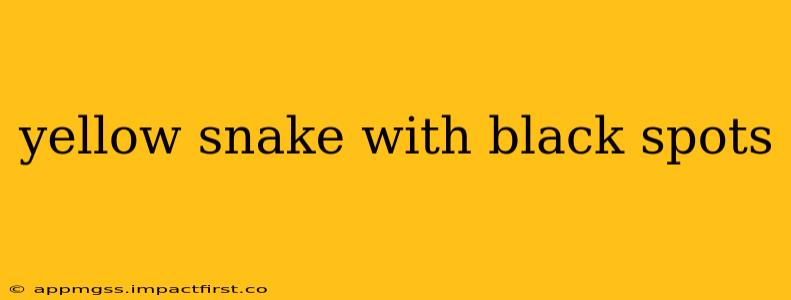Many snake species boast a yellow and black spotted pattern, making identification crucial for safety and responsible wildlife interaction. This guide will help you narrow down the possibilities and understand what to do if you encounter such a snake. Remember, never handle a wild snake; always maintain a safe distance and contact local wildlife authorities if necessary.
What kind of yellow snake with black spots did I see?
This is the most common question, and unfortunately, the answer depends heavily on your geographic location. The coloration and pattern can vary even within the same species, making visual identification alone challenging. To help pinpoint the specific snake, consider these factors:
- Location: The region where you spotted the snake is critical. A yellow and black snake in Florida is far less likely to be the same species as one seen in California. Be specific – state, county, and even the type of habitat (forest, field, near water) will all aid in identification.
- Size: Was the snake small (under a foot), medium (1-4 feet), or large (over 4 feet)? Size is a significant factor in differentiation.
- Shape and Body Type: Was the snake slender, thick-bodied, or robust? Did it have a noticeable head shape (distinct from the neck, triangular, etc.)?
- Behavior: Was the snake aggressive, defensive, or docile? Knowing its demeanor can sometimes provide clues about its species.
- Pattern Details: Were the spots evenly distributed, or were there bands or stripes alongside the spots? The arrangement of the black markings is key. Were the spots round, oval, or irregular?
What are some common yellow snakes with black spots?
Several snake species exhibit a yellow and black spotted pattern, and some examples include:
- Western Ribbon Snake (Thamnophis proximus): This species is often found in the western United States and displays a yellow or greenish-yellow body with black spots or blotches.
- Rough Greensnake (Opheodrys aestivus): Although primarily green, some Rough Greensnakes can exhibit a yellow base with black markings, particularly juveniles. These snakes are found throughout the southeastern United States.
- Several species of Racer Snakes: Some racer snake subspecies can have yellow or yellowish-green bodies with black spots or blotches, depending on their geographic location and age. These are often more slender than other species.
- Other regional variations: Many less common or regional variations of various snake species could also exhibit a similar coloration.
Is this snake poisonous?
This is a crucial question, and unfortunately, it cannot be definitively answered without specific details about the snake's characteristics and location. Many snakes with a yellow and black spotted pattern are non-venomous. However, some venomous snakes might exhibit similar coloration. This makes accurate identification imperative.
How can I identify the snake more accurately?
To improve your chances of identification:
- Take a high-quality photograph: Multiple photos from different angles are even better. Include a clear view of the head, body pattern, and overall size relative to a known object (ruler, etc.).
- Use a field guide or online resources: Numerous websites and apps provide detailed information about snake identification. Use your location as a critical search filter.
- Consult a herpetologist or wildlife expert: If you're still unsure, contact a local herpetologist or wildlife professional for assistance. They can often help identify the snake based on your description and photograph.
What should I do if I encounter a yellow snake with black spots?
- Maintain a safe distance: Avoid approaching or handling the snake.
- Observe the snake carefully (from afar): Take note of its size, shape, pattern, and behavior.
- Do not attempt to kill the snake: Snakes play a vital role in the ecosystem.
- Alert children and pets: Keep children and pets away from the snake.
- Contact local wildlife authorities or a snake removal service: If the snake is in a dangerous location or you feel threatened, contact professionals for assistance.
Remember, accurate identification of snakes is crucial for your safety and the snake's well-being. Use this guide as a starting point, but always consult reliable resources and experts for definitive identification. Never handle wild snakes.
